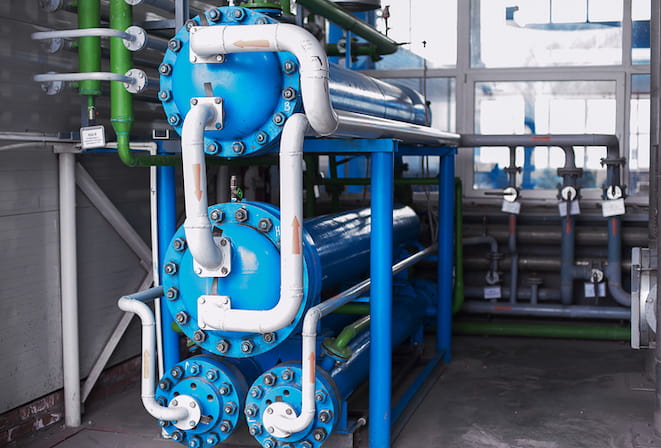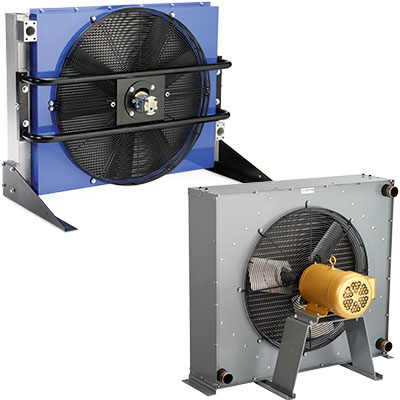Advancements in Heat Transfer Systems: What You Required to Know for Optimum Efficiency
Technologies in Heat transfer systems are transforming efficiency across numerous markets. Advanced products like graphene and nanofluids guarantee considerable enhancements in thermal conductivity. The assimilation of IoT and machine learning supplies opportunities for real-time tracking and boosted energy effectiveness. The landscape of thermal monitoring is rapidly developing. Understanding these growths is vital for achieving ideal system performance and sustainability in the future. What details developments are forming this change?
Emerging Materials for Improved Heat Transfer

Advanced Heat Exchanger Styles
While traditional Heat exchangers have served their objective in different applications, progressed layouts are currently arising to fulfill the enhancing demands for effectiveness and efficiency. These innovative layouts, such as plate, shell-and-tube, and finned-tube Heat exchangers, include boosted surface and boosted circulation patterns to boost thermal transfer rates. On top of that, small designs permit lowered space needs without jeopardizing performance. Advanced materials, such as composites and corrosion-resistant alloys, in addition enhance toughness and efficiency under severe conditions. Furthermore, simulation innovations and computational fluid characteristics are significantly employed to refine these layouts, ensuring peak Heat transfer features. As sectors look for to lessen power usage and take full advantage of outcome, the adoption of sophisticated Heat exchanger layouts is essential in accomplishing these objectives.
The Role of Nanotechnology in Heat Transfer
Nanotechnology plays an important duty in boosting thermal conductivity within Heat transfer systems. By adjusting materials at the nanoscale, scientists have actually attained significant enhancements in power effectiveness. These developments not just enhance efficiency yet likewise add to more sustainable power remedies.
Boosted Thermal Conductivity
Considerable advancements in thermal conductivity have arised via the application of nanotechnology, revolutionizing Heat transfer systems throughout numerous industries. By integrating nanoparticles into Heat transfer liquids and materials, researchers have actually accomplished exceptional increases in thermal conductivity. These nanoparticles, such as carbon nanotubes, graphene, and metal oxides, enhance the Heat transfer properties due to their high surface and special thermal characteristics. The resulting compounds show improved efficiency in applications varying from electronic devices cooling systems to sustainable power innovations. Furthermore, the ability to customize the size, shape, and composition of nanoparticles enables optimized thermal management services. Therefore, nanotechnology remains to play an essential role in the development of more efficient and efficient Heat transfer systems, leading the way for improved industrial applications.
Energy Effectiveness Improvements

Integration of IoT in Heat Transfer Equipments
The combination of IoT in Heat transfer systems presents the execution of smart sensors that enhance functional performance. These sensing units make it possible for real-time information monitoring, permitting prompt modifications and optimizations. This technological advancement has the possible to considerably improve performance and energy monitoring in Heat transfer applications.
Smart Sensors Application
As Heat transfer systems develop, the combination of wise sensors via the Internet of Points (IoT) has actually become a transformative strategy. These sensing units make it possible for real-time monitoring of flow, temperature, and stress rates, boosting system performance and dependability. By gathering and sending data, they help with proactive maintenance, decreasing the danger of system failings. In addition, wise sensing units add to power savings by refining operational criteria based upon ecological problems. Their capability to analyze patterns and anomalies enables educated decision-making, making certain peak efficiency of Heat transfer systems. As industries increasingly adopt this innovation, the application of wise sensors stands to revolutionize how Heat transfer systems are handled, paving the way for higher sustainability and improved efficiency end results.
Real-Time Information Tracking
Just how can real-time data keeping track of improve the performance of Heat transfer systems? By integrating Web of Things (IoT) innovation, Heat transfer systems can take advantage visit this website of constant information collection from smart sensing units. This real-time tracking enables for prompt analysis of temperature level, flow, and pressure prices, making it possible for drivers to determine inefficiencies without delay. As a result, changes can be made to enhance efficiency, minimize power intake, and extend tools life expectancy. Furthermore, anticipating upkeep can be applied, reducing unanticipated downtime and costly repair work. The capacity to envision performance metrics through control panels boosts decision-making, fostering a proactive method to system management. Ultimately, real-time information keeping an eye on not just enhances operational efficiency yet likewise adds to sustainability objectives within commercial processes.
Energy Efficiency and Sustainability Trends
Power efficiency and sustainability fads are reshaping the landscape of Heat transfer systems, driving innovation and compliance throughout different markets. Organizations are significantly focusing on energy-efficient styles to decrease operational expenses and decrease environmental impacts. The assimilation of renewable power resources is becoming more common, allowing Heat transfer systems to operate sustainably while satisfying regulative demands. In addition, advancements in technologies and products advertise lower power usage and enhance general efficiency. Lifecycle evaluations are additionally gaining traction, permitting business to evaluate the ecological influence of Heat transfer systems from production to disposal. This focus on sustainability not just supports business responsibility yet additionally settings companies competitively in a market where consumers increasingly favor green options. Consequently, energy performance and sustainability stay vital considerations for future developments in Heat transfer modern technology.
Developments in Thermal Management Solutions
While the demand for reliable Heat transfer remains to increase, innovations in thermal administration remedies are emerging to deal with both efficiency and sustainability obstacles. Advanced materials, such as stage modification materials and nanofluids, are being developed to enhance Heat transfer effectiveness - DVS Heat Transfer Systems. These products boost thermal conductivity and permit for much better temperature guideline in numerous applications. go to this website Furthermore, innovations like energetic thermal control systems are obtaining grip, enabling real-time changes to manage Heat circulation successfully. These systems add to energy savings and reduce the ecological effect of thermal processes. The combination of IoT in thermal management helps with tracking and predictive upkeep, ensuring optimized performance and long life of Heat transfer systems. Generally, these innovations stand for significant strides toward more sustainable thermal monitoring practices
Future Directions in Heat Transfer Innovation
Arising developments in thermal management options signal a promising future for Heat transfer innovation. Researchers are progressively focusing on developing products with remarkable thermal conductivity and improved power performance. Innovations such as nanofluids, which include suspended nanoparticles, provide significant enhancements in Heat transfer performance. In addition, the assimilation of smart products that adapt to varying temperature level conditions is acquiring grip, permitting more receptive and effective systems. The increase of additive manufacturing strategies is likewise enabling the design of intricate Heat exchanger geometries that optimize liquid flow. Furthermore, the execution of device knowing algorithms is prepared for to reinvent the optimization of Heat transfer systems, helping with anticipating upkeep and efficiency improvement. Collectively, these innovations are positioned to change the landscape of Heat transfer technologies in different industries.

Often Asked Questions

Exactly how Do I Select the Right Heat Transfer System for My Application?
Selecting the appropriate Heat transfer system involves examining application requirements, including temperature varieties, liquid residential or commercial properties, and performance needs. Examining system kinds, upkeep considerations, and cost-effectiveness also plays an important function in making a notified decision.
What Are the Maintenance Requirements for Advanced Heat Exchangers?
Upkeep requirements for sophisticated Heat exchangers generally include routine assessments, keeping track of for leakages, cleaning of surfaces, and guaranteeing ideal circulation prices. Sticking to supplier standards guarantees efficient procedure and lengthens the tools's life-span.
How Do Environmental Factors Influence Heat Transfer Performance?
Environmental factors considerably affect Heat transfer efficiency. Variants in temperature level, moisture, and air flow impact thermal conductivity and convective Heat transfer, eventually influencing system efficiency and requiring factor to consider throughout the style and operation of Heat transfer systems.
What Security Standards Apply to Heat Transfer Systems?
Safety and security requirements for Heat transfer systems normally consist of standards from companies such as ASME and ASTM. DVS Heat Transfer Systems. These requirements address materials, style, and operational methods to assure integrity, performance, and security versus hazards in various applications
How Can I Fix Typical Heat Transfer System Issues?
Repairing common Heat transfer system issues includes examining for leakages, making sure correct fluid circulation, examining insulation honesty, and validating temperature differentials. Determining these factors can assist preserve system performance and prevent further issues.
Nanotechnology plays an important role in enhancing thermal conductivity within Heat transfer systems. Considerable advancements in thermal conductivity have arised via the application of nanotechnology, revolutionizing Heat transfer systems throughout different markets. Advancements in thermal conductivity via nanotechnology have actually internet led the method for amazing enhancements in power performance within Heat transfer systems. Power efficiency and sustainability patterns are reshaping the landscape of Heat transfer systems, driving innovation and compliance across numerous markets. The combination of IoT in thermal monitoring facilitates surveillance and anticipating upkeep, ensuring optimized performance and longevity of Heat transfer systems.